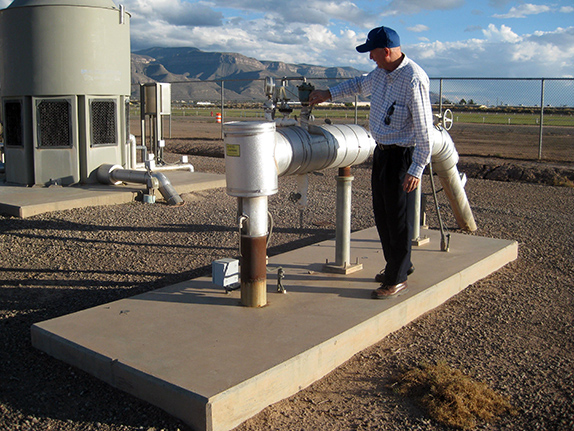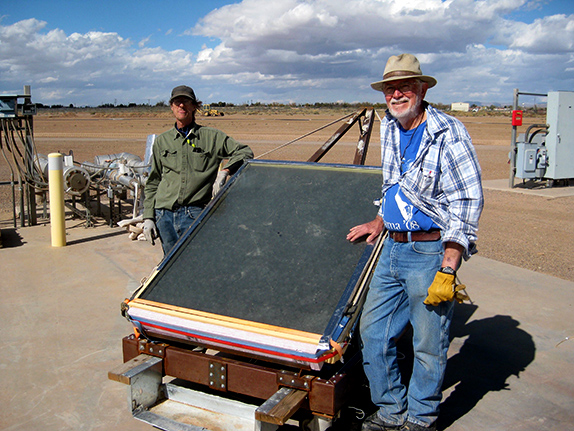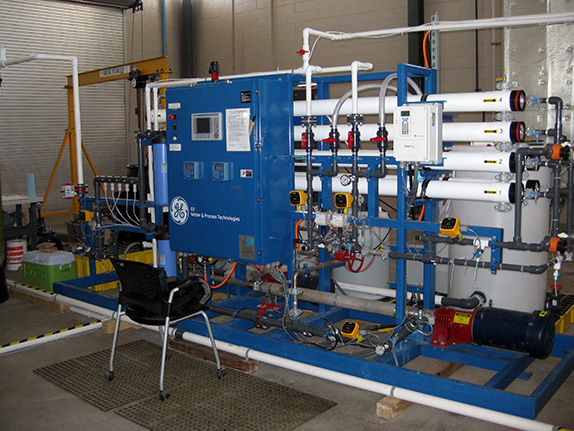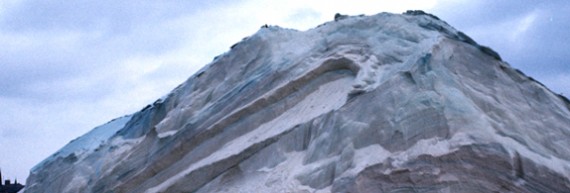Just outside of Alamogordo, an isolated windswept building that somehow suggests an ancient civilization houses the prosaically named Brackish Groundwater National Research Center, opened in 2007 by the Bureau of Reclamation. It might be the best-kept secret in New Mexico. Randy Shaw, the director, shown below inspecting one of the Center’s wells, tells of the ironies in his soft spoken Hobbs accent. A lot of people, he says, assume that they are the water utility for the town. Nothing could be further from the truth. The U.S. Agency for International Development called recently to discuss use of the Center to hold a global competition for the most innovative designs to clean brackish groundwater and seawater. Its unassuming status may be fading fast. Senator Heinrich visited for two hours last summer, and New Mexico First just contacted them to help with a town hall meeting around their 2014 water theme. Clients who use their research facilities range from the Navajo Nation to New Mexico State to a Dutch water company, among many other communities and institutions.

Randy came to the center in 2010 after years with BIA working on Native American water management. I came for a two-day visit out of curiosity. I’m a researcher trying to learn New Mexican water governance. When I went to a water conference last year, student posters were on display. Several reported graduate projects on desalination, a concept I knew nothing about. An Iranian student patiently explained the concept. Ironically enough, she has a project running right now in one of the “bays,” the areas designated for development of and experiments with “desal” technology.
What’s with desal? As the graph below shows , it has accelerated in recent years on a world-wide basis. Like everything else in waterworld, it’s a complicated story. I shouldn't have expected anything less. I’ve spent the last couple of years learning how much I don’t know about New Mexico water law. Desal is just as bad for a newcomer, but it starts with chemistry instead of legal jargon and ends with business instead of court.

First of all, “salt” doesn’t just mean sodium chloride, ordinary table salt, though it can mean that as well. It means any number of compounds that dissolve in water. What they are and how much of them are in the water depend on context, on the nature of the bio-geophysical location and on what people have done to it before it shows up at the intake valve. The water can come from any number of sources, seawater and brackish groundwater, as mentioned already, but also wastewater and the new kid on the block, “produced” water, the by-product of oil and gas drilling. How it is treated will also depend on its uses--agricultural, industrial or human consumption. The purpose is the same in all cases--treat the water so that what comes out is pure enough for the purpose, in the case of high end drinking water, clean, safe for humans and with that fresh water taste. Think of all the different “it’s the water” ads.
This isn’t a new concept, nor is it alien to ordinary life. At the Alamogordo Center I met Hill Kemp, a visiting researcher shown in the picture below, who says he relies on Aristotle because he is developing an improved version of solar distillation suited to the desert. That is about as low-tech as you can get. And Randy described his own “reverse osmosis” system in his kitchen--more on that concept in a moment--available at the home improvement store of your choice.

Desal has been around for a long time. But lately it seems to have taken off, partly due to technology, partly due to the tipping point in global water awareness over the last few decades. Aldo Leopold used water in his 1949 A Sand County Almanac to show how humans take nature for granted even as they use it up. People think that water is just a matter of turning on the tap. He meant people like me who grew up in affluent post-war economies. Water? There’s plenty of it and it’s clean and cheap and safe to drink.
Many, probably most in the world, haven’t had the luxury of those assumptions. Now, in 2013, UN-Water predicts that by 2025, 1800 million people will live in regions of water scarcity and two-thirds of the world’s population “could be under stress conditions.” Water use grew at more than twice the rate of population growth in the previous century. . New Mexican readers won’t need local statistics to convince them that there are water problems in the Land of Enchantment as well.
So why not use new water and make better use of old water? Most of the desalination in the world involves the ocean, not a promising approach in a state that’s mostly beach. But various sources claim millions of acre-feet of brackish water deep underneath us. I don’t know how they calculate those numbers, but they translate into “one hell of a lot.” Oil and gas wells, whatever your feelings about extractive industries, produce a lot of water as a byproduct. Why not clean up this so-called “produced water” and re-use it? Recycling wastewater, the famous “toilet to tap” movement, you should excuse the expression--whoever coined that phrase should be punished for the public relations problems it has created--uses desal to put the final polish on treated wastewater.
So, why not? Well, taking salts out of water uses a lot of energy. And when you’re done, you’re left with a lot of salts to dispose of harmful to man, beast and plant. With deep brackish water, once you pump it out it’s gone. And “gone” means people who came for it are dry again and, worst case scenario, the empty aquifer causes the land to subside. As if that weren’t bad enough, sucking all that water up from the earth might have contaminated sweet ground water above it.
So now we’ve gone from “why not” to “what were you thinking?”
Trapped in this contradiction between bounty and apocalypse, I decided to drive to Alamogordo and see for myself. The problems and issues in the list above are, in fact, research and development projects at the Center, alive and well in the conversations I had with the staff and researchers I met there. And not only at the Center. My own research uncovered numerous journals, professional associations, and conferences about “AWT,” advanced water treatment, from all over the world.

Let me describe some of the basics I learned in my two day immersion course, no hydraulic pun intended. How does this desal business work? The heart of it in most applications is “reverse osmosis,” which sounds like a good name for a band. The above picture is of an experimental setup in one of the bays. To oversimplify, “osmosis” means that, when salts dissolve in a container of water, they want to distribute evenly throughout the liquid. If you take a bowl and divide it in half with a piece of plastic that has a little hole in it, and then pour salt water in one side and fresh water in the other, the salt will move through the hole until the salinity evens out. Force of nature. No human effort need apply.
The “reverse” part means, take a liquid with that even distribution and “un-osmosis” it, that is, push the fresh water from the dissolved salt. How? By forcing the water through a membrane that will let the water pass through but block the salts. Development of this technology explains why the curve in that graph turns upward around the 1960s. So, one pipe out of the desal machine yields fresh water; the other pipe, the appropriately named “concentrate,” the salty goop toxic to plants and animals, certainly not something you’d want to add to your bourbon.
The force required to do the pushing is where a major energy cost comes in, but things have gotten better over the years. There is a “minimal theoretical energy” required to get salts out of water, an amount that you can’t improve on. In the 1960s, when desal was taking off, it took about 20 times more than the minimum to get the salts out. Today it’s down to less than twice the amount.
Some research at the Center looks at pairing reverse osmosis with renewable energy sources, so far on small scales. The Navajo, for example, partner with the Center on a project for local desal since many of the communities or “chapters” have no local access to drinking water at all. Small desal units with solar power can provide it. Portable “expeditionary units” are used by the military. One was flown into Biloxi after Hurricane Katrina to provide water for the regional hospital.
Then there’s “zero-discharge desalination,” ZDD they call it, a kind of dialysis that relies on electric current to desalinate the water rather than forcing the salts out by pressure. Salts dissolve in water into their constituent chemicals in their “ion” form, meaning they have either the positive or negative charge that originally bound them together. Once again to oversimplify, imagine water flowing through a box with battery-like terminals on the top and the bottom, one positive, one negative, and imagine the water flows through it. The picture above shows Karl Dykeman putting an experimental version in place. The positive ions are pulled to the negative pole, the negative ions to the positive one, and desalinated water flows out. A French company that runs projects at the Center has achieved 98% recovery, meaning that most all of the brackish water that goes in comes out as fresh water. There’s still the salts to deal with, but the liquid is mostly gone.

One way to deal with the concentrate is to use it for something else. The Center is developing part of its 40-acre plot of land to work on “enhanced evaporation,” and more interestingly, on uses of concentrate with salt-friendly plants to grow livestock food supplements. In the air at the moment, a major global fertilizer producer proposed what the Center staff sitting around the lunch table astounded me with. The basin where Alamogordo is located is said to have several trillion gallons of brackish water in deep aquifers. Because of the particular chemistry of the local water, the fertilizer magnate can use the concentrate taken out of the water as an input into fertilizer production. He offers to build a desal plant, for free, and to provide water to the city at low agricultural, rather than high urban utility prices, because he wants the concentrate the desal will produce for his fertilizer. To me personally this verged on the “too good to be true” category, but it didn’t sound impossible either. And then it isn’t a free lunch. Fertilizer has created problems with runoff and declining surface water quality in many parts of the world. I plan to check back in six months or so.
There are many more lessons to report, like the critical roles of “pre” and “post” treatment of water that goes into and come out of the desal machinery, also a major focus of research projects at the Center and elsewhere. In a two-day visit, I only flew over an elaborate territory, but I wanted to show a reader that the territory exists.
As I headed north and home--what a pleasure to drive to a project instead of dealing with air travel--I noticed the occasional windmill with a few head of cattle gathered around it. Water. There’s not enough of it, neither in New Mexico nor in the world as a whole. In 2010 the UN General Assembly passed a resolution affirming that access to clean water was a human right. One hundred and twenty-two countries supported the resolution, none voted against it, though 41, including the U.S., abstained. This noble statement inspires me as a moral compass to use when I think about what I’m doing with my water research.
It is clear that new technology is going to play a role in the planet’s waterworld future. There’s of course grounds for critical caution here, but it is in fact looking more and more likely with the upward turn in research and development, as exemplified by the Brackish Groundwater National Research Center in Alamogordo. Could it play a role in serving that noble principle of water as a human right? I think it already shows signs that it could.
The problem is it could play other roles as well. Consider the capitalist villain, like the controversial Sesame Street character Tex Richman, for whom all that matters is continuous increase in the short-term bottom line in an infinite upward spiral, by whatever means necessary. With that kind of capitalism in control, the old waterworld cliché, that water flows uphill to money, will apply to desalinated water as much it does to any other kind. This not only fails to serve the moral principle. It subverts it. On the other hand, some capitalist heroes need to be part of the story, like Hill Kemp inventing a contemporary version of a solar still. He’s a businessman who was celebrating a new patent that he received just before my visit.
Or consider another term I hear at water conferences, “water security.” Wars are fought over water. In this scenario, desalination turns into another piece on the chessboard of realpolitik, a rerun of the oil story, where strategic alliances, national policy, and international confrontations center on protecting and securing more natural resource for a nation-state. I understand that this is part of how the world works, but it bears a problematic relationship to the moral principle. It could serve it, if “water security” were linked to “human right” in a specific case, for example in a global response to a hydraulic dictator. But it doesn’t inspire me personally as much as the U.N. declaration does. Worse, security for one country might mean no water for another.
The problem, as always, is that we modern humans tend to think of technology like desalination and natural resources like water as objects separate from what they really are, namely, patterns woven into the fabric of our everyday lives, the very point that Aldo Leopold made in his book so long ago. The technology is interesting, improving and likely will be useful more and more as the years go on. The issue is, just exactly why is it "interesting," "improve" in what way, and for what purposes from whose perspective? And how will it change our relationship, however out of awareness it might be, with water?
Questions like these aren’t part of hydrology and engineering. So as I drive home I’m back to water governance, where I started the trip, only with more knowledge about yet another complicated corner of waterworld that can help or hinder that moral principle of water as a human right, depending on how we put the technology into practice. From the human perspective we have to ask, who makes the rules, how are they applied, and how are they enforced? Those are classic governance questions, and the answers we give will produce the scenario that our answers deserve. Me, I’m rooting for the U.N. declaration as the primary feature in the map to navigate the future with, but I know that the economy and political conflict will be part of that future as well.
One conclusion to my two day visit stands out. New Mexico? My state now trying to have a conversation about water and still not finding the right words? There is a wealth of knowledge and smart principled people working away on desal technology in the Tularosa Basin. They should be sitting at the state water table--once again no hydraulic pun intended--as we try and figure out our water future.




Responses to “Water, Water Everywhere, But Too Much Salt To Drink”